- AI Fire
- Posts
- 🤯 4 Smart Strategies To Build An Entire AI Marketing Team
🤯 4 Smart Strategies To Build An Entire AI Marketing Team
You don't need more staff. This guide shows how to use free Google tools to build AI Strategists, Data Analysts, and Creative Directors

TL;DR BOX
Google’s ecosystem provides a comprehensive, mostly free stack to automate four core marketing functions: strategy, data analysis, creative production and workflow automation.
By pairing Gemini’s research with NotebookLM’s synthesis, marketers can create grounded strategies and measure performance against KPIs. Creative tools like Mixboard and Whisk handle asset production, while Opal builds custom no-code apps to systematize repetitive tasks. This structure shifts human focus from execution to strategic direction.
Key points
Fact: NotebookLM now supports Google Sheets, allowing direct correlation analysis between strategy documents and performance data.
Mistake: Over-automating tasks that require human judgment or failing to enforce brand consistency.
Action: Create a "Brand Voice Gem" to ensure all AI-generated copy consistently matches your specific tone.
Critical insight
Value lies in cross-referencing strategy documents with actual performance data in NotebookLM, reducing hallucination by grounding insights in your specific business reality.
🆘 What’s the #1 bottleneck in your marketing? |
Table of Contents
I. Introduction: Stop Chasing Features, Start Building an AI Marketing System
Google's Gemini model is getting incredibly powerful and the Google AI stack is evolving fast. But here's the truth most people miss: chasing the latest shiny feature won't help you with AI marketing. AI models become outdated quickly. Focusing on the "newest bell and whistle" is a losing game.
Instead, we need to focus on methodology and fundamental use cases.
In this guide, I'll show you how to build a complete AI Marketing Assistant Team using Google's ecosystem. This isn't about replacing marketers. It's about building a system for day-to-day tasks (organized around strategy, data analysis, creative production and workflow automation) so you can work smarter, not harder.
This is your blueprint for an AI-powered marketing operation.
II. What Are The Four Core Functions Of An AI Marketing Team?
Think of this as hiring four distinct AI specialists for your team.
AI Marketing Strategist: Handles research and planning.
AI Data Analyst: Manages performance measurement and insights.
AI Creative Director & Copywriter: Leads visual and content creation.
AI Builder: Automates workflows and builds custom tools.

Important Principle: This is always AI + Human. Think of these assistants as handling the 80% of tasks that are repetitive or data-heavy, freeing you to focus on the 20% (the high-impact strategy and creative direction) that truly makes a difference.
Learn How to Make AI Work For You!
Transform your AI skills with the AI Fire Academy Premium Plan - FREE for 14 days! Gain instant access to 500+ AI workflows, advanced tutorials, exclusive case studies and unbeatable discounts. No risks, cancel anytime.
III. Function #1: AI Marketing Strategist (Gemini + NotebookLM)
Great marketing starts with a solid strategy. To build this function, we pair the powerful research capabilities of Gemini with the incredible synthesis power of NotebookLM.
Use Case: Online Course Platform Launch
Let's walk through a real-world example: launching a new online course platform.
Step 1: Deep Research with Gemini
Action: Access Gemini and turn on "Deep Research" mode.
Key Update: Gemini now allows you to use your own sources or upload files as part of the deep research process. This grounds the AI in your specific reality.
The Output: You get a detailed research report covering your target audience, key market players, pricing model comparisons and prioritized marketing channels.
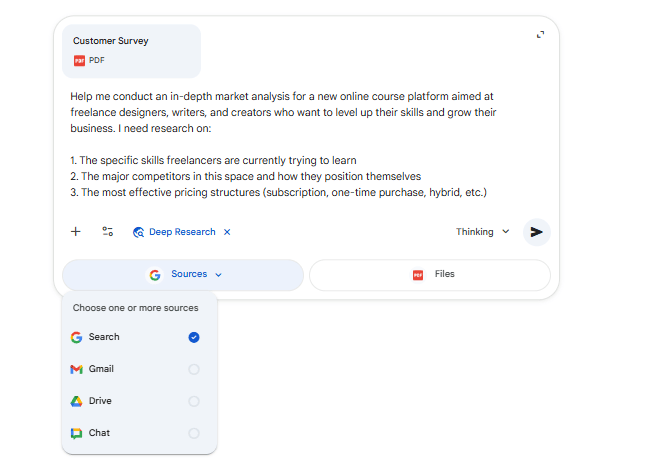
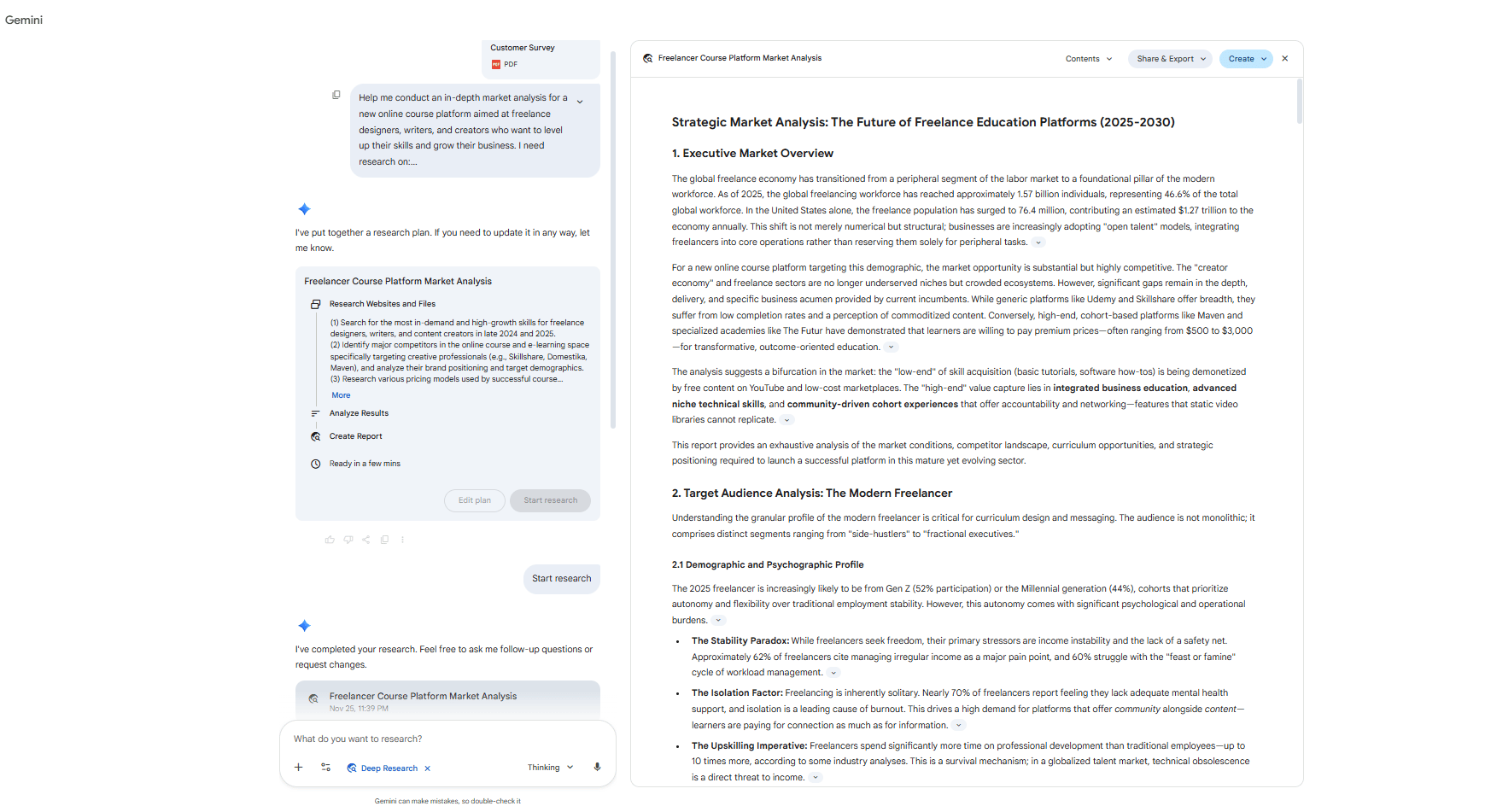
Step 2: Export to Google Docs
Action: Export the research directly to a Google Doc.
Why: This prepares the data to be imported into our next tool, NotebookLM.
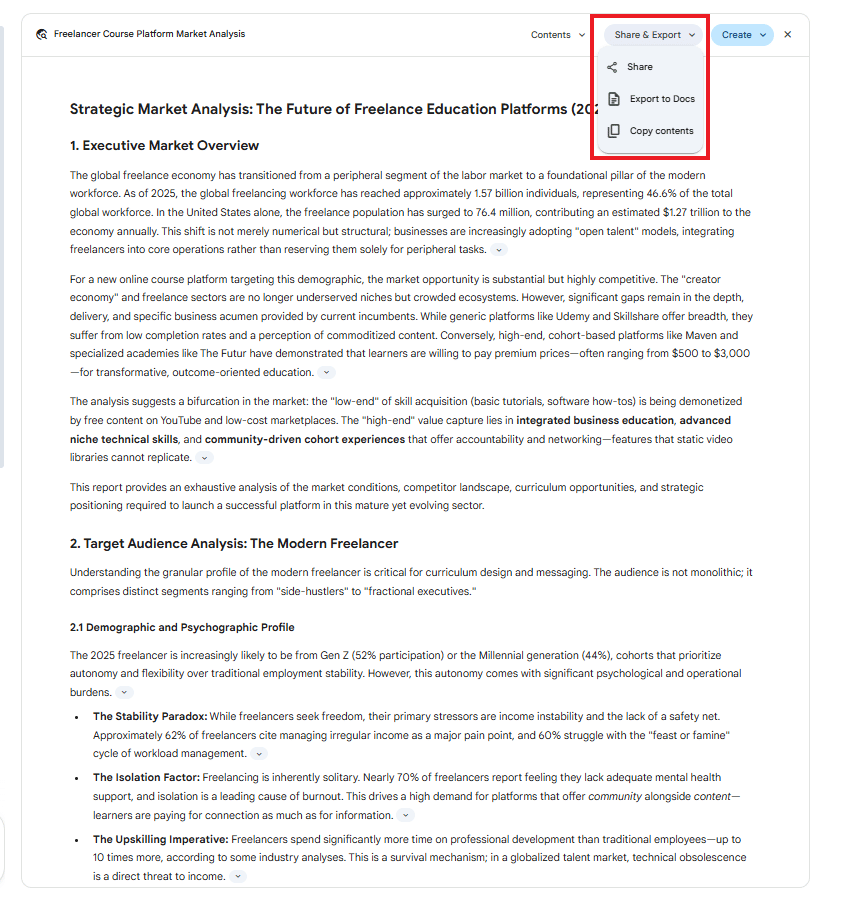
Pro Tip: You can now perform research directly inside NotebookLM but I find building a centralized knowledge base first is often cleaner.
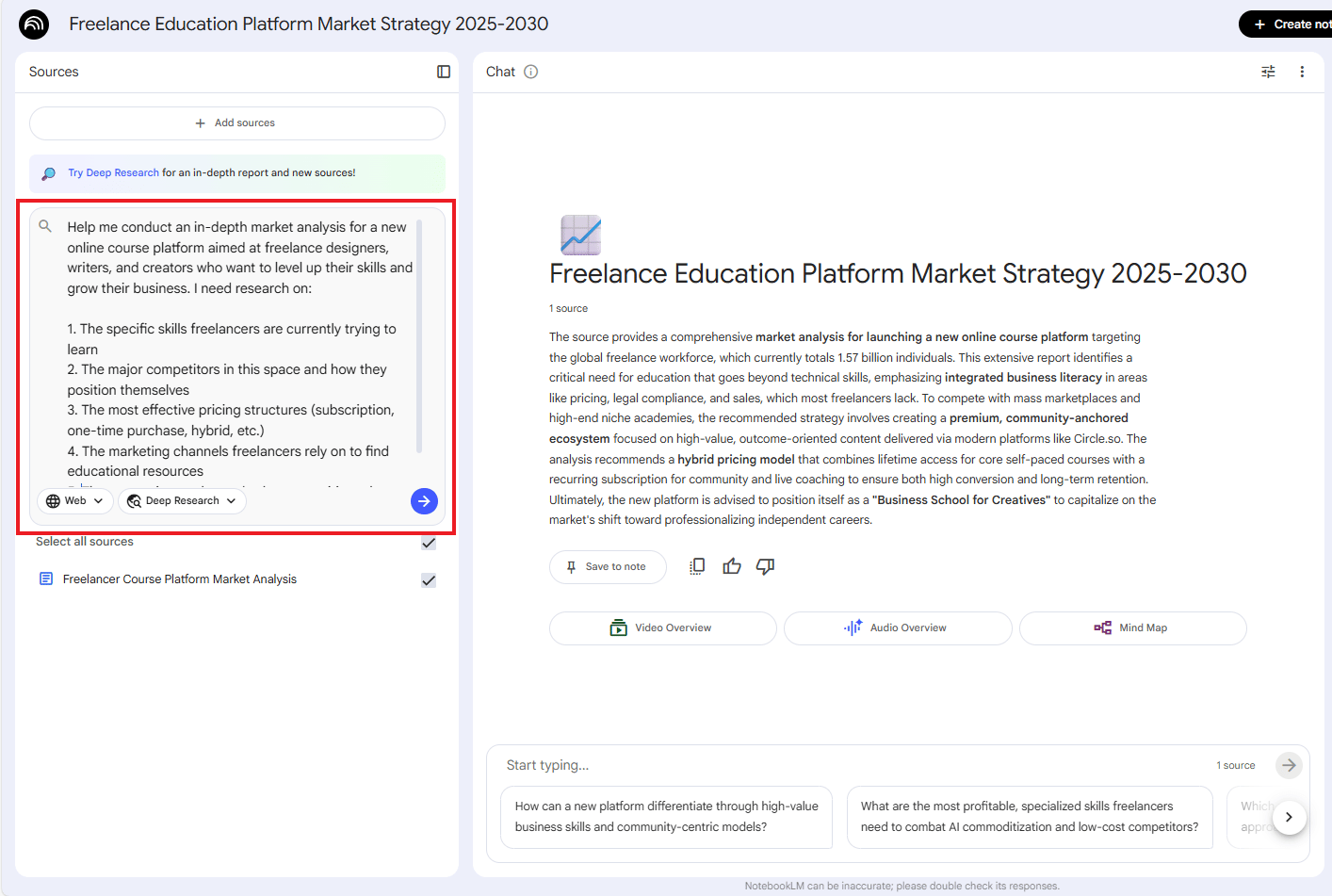
Step 3: Build Knowledge Base in NotebookLM
Action: Import your research Google Doc into NotebookLM. Then, import additional sources: online learning market trends, popular course topics and, critically, your own product overview.
Why This Matters: NotebookLM only uses the sources you import. This ensures your strategy recommendations are grounded in what it knows about your specific product, not just generic internet advice.
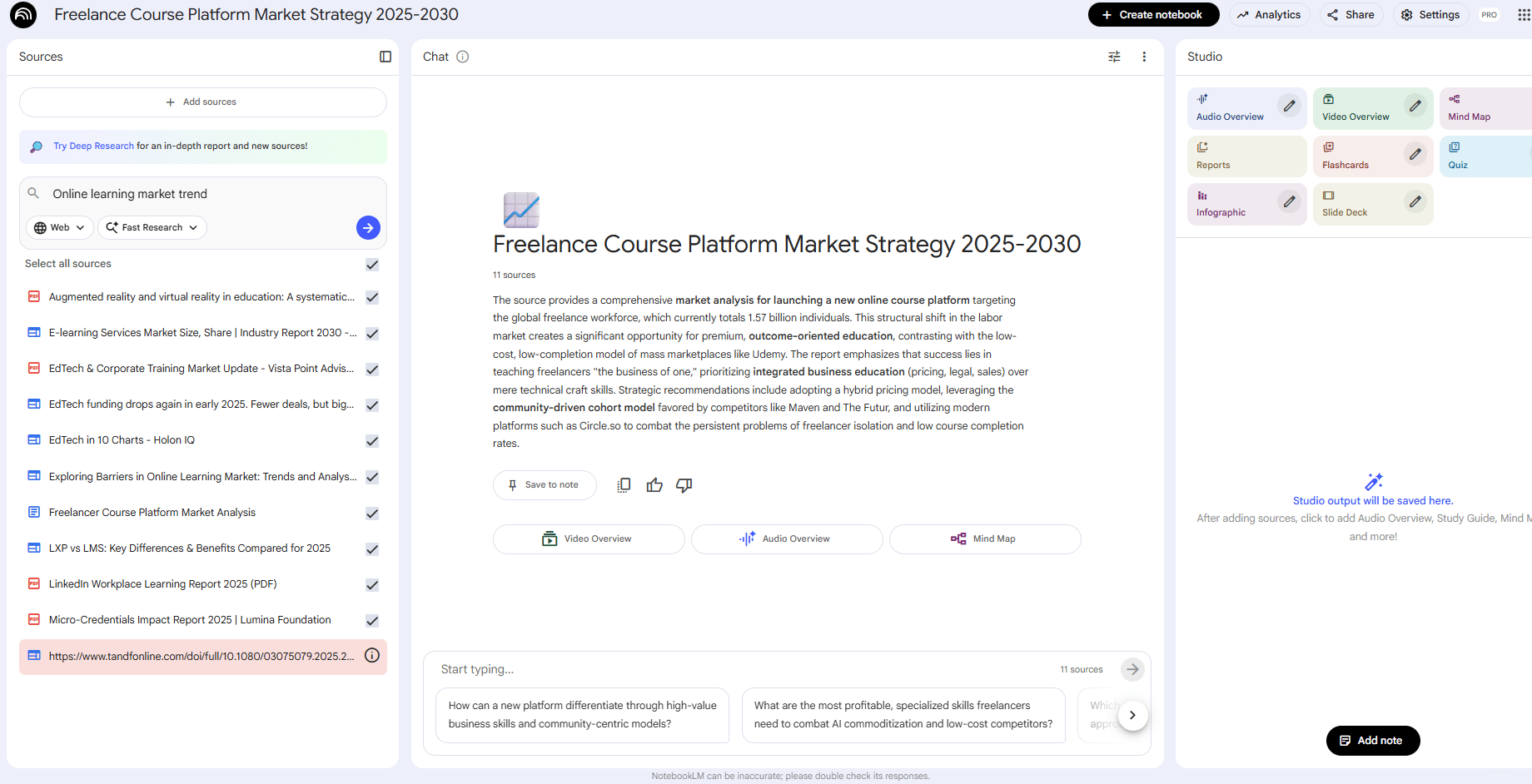
Pro tip: You can customize your output by going to the “Configure Chat” feature to define your chat goal.
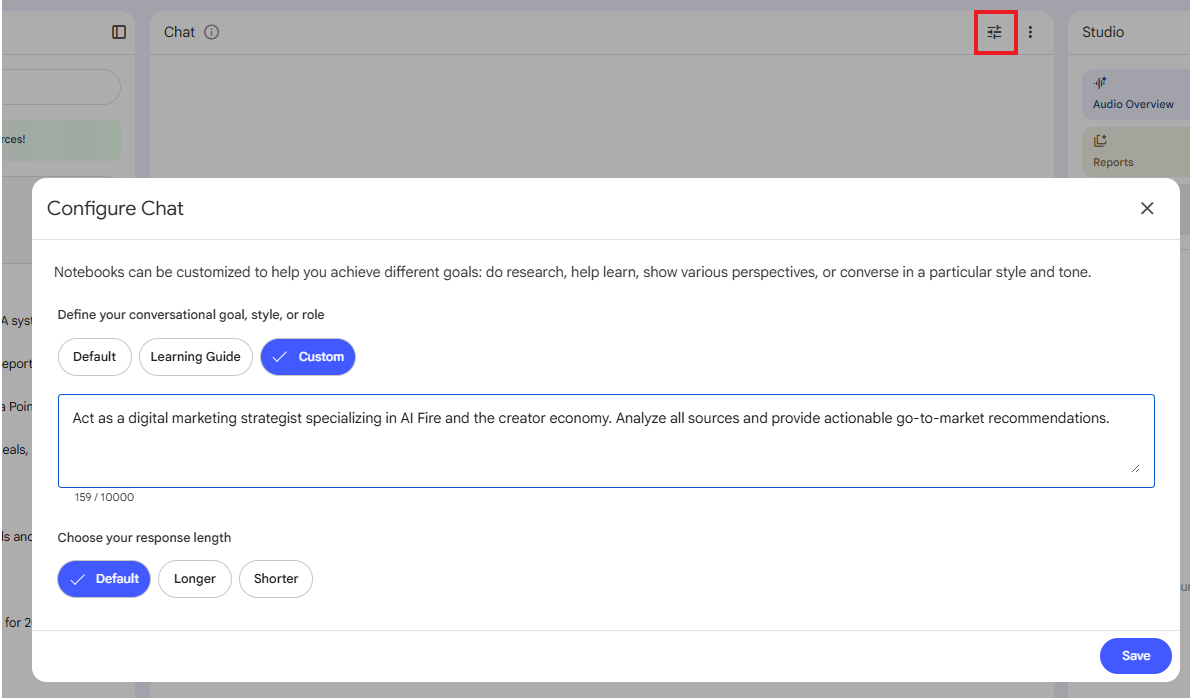
Step 4: Create Strategy Report
Action: Use the "Create Report" feature in NotebookLM with this prompt:
Create a full go-to-market strategy plan for the launch of AI Fire’s platform. The document should include:
1. A clear positioning statement and messaging framework.
2. Defined audience segments with prioritization.
3. A pricing approach with reasoning behind each choice.
4. Recommended marketing and sales channels, including suggested budget allocation.
5. A 90-day action plan for the launch.
6. Core metrics to track for measuring success.The Output: A complete strategy plan including positioning, pricing, channel recommendations and budget allocations.
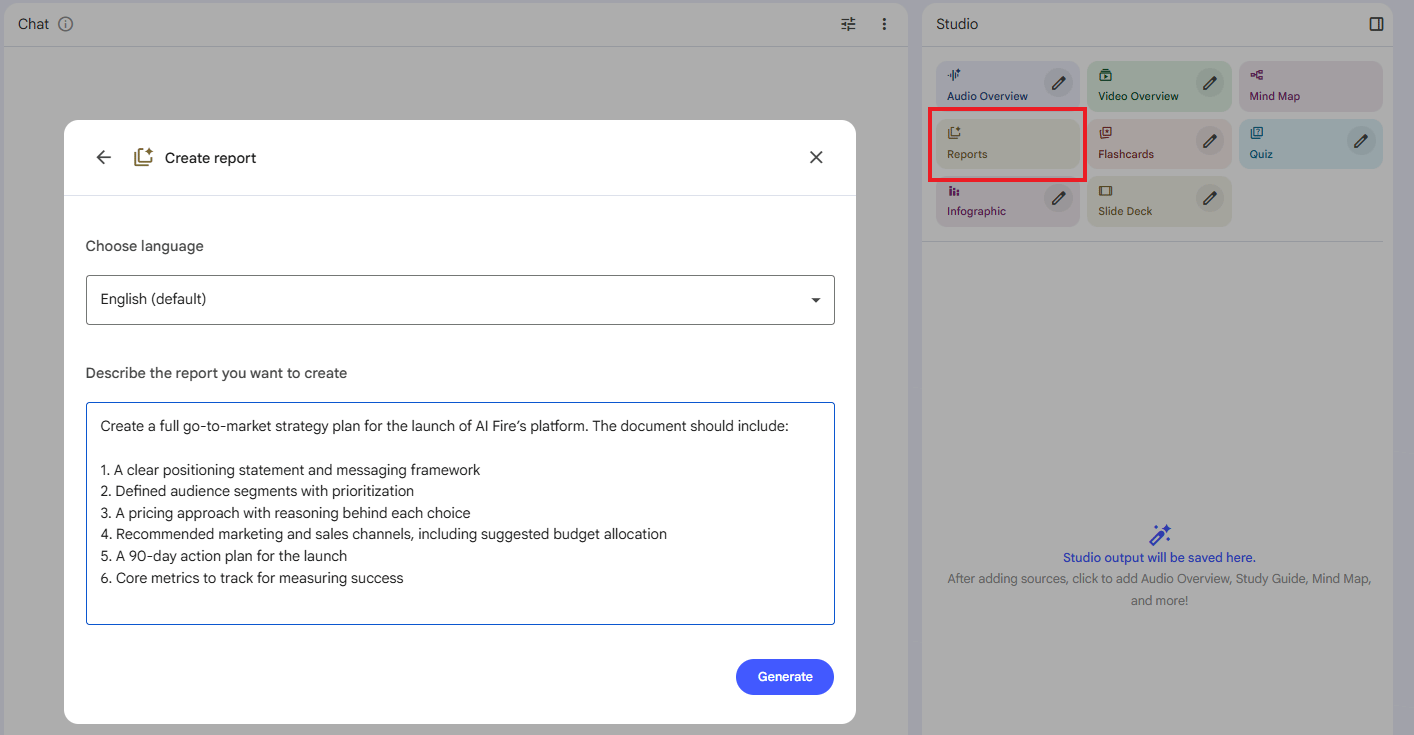

Step 5: Create Presentation Deck
Action: Import that new strategy document back into NotebookLM as a source. Select only this source and ask:
Create a structured outline for a 15-slide presentation covering AI Fire’s full go-to-market strategy. For each slide, provide: A clear slide title, the main points that should appear on the slide, suggestions for supporting visuals or data to include. Do not include any tables in the response.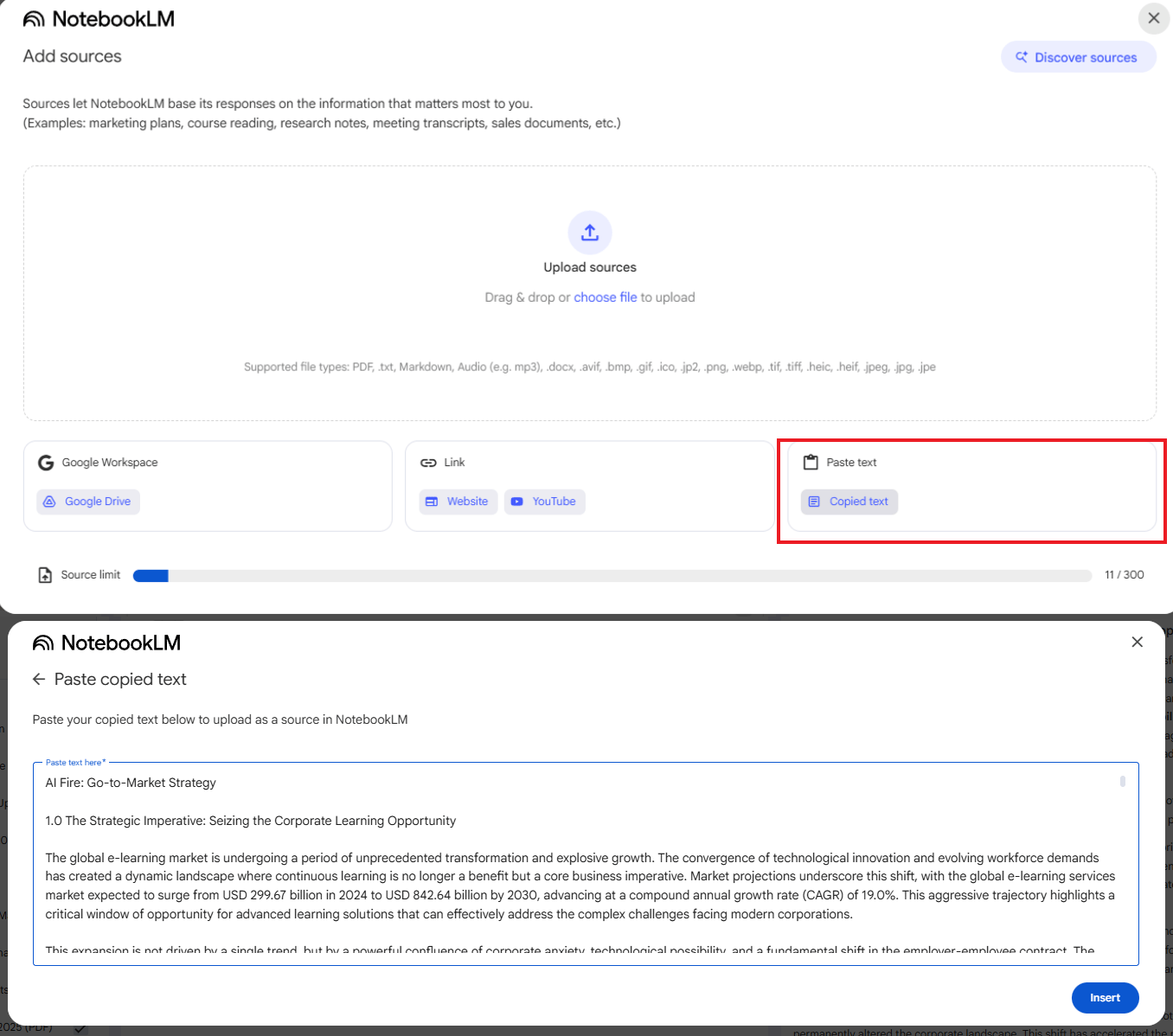
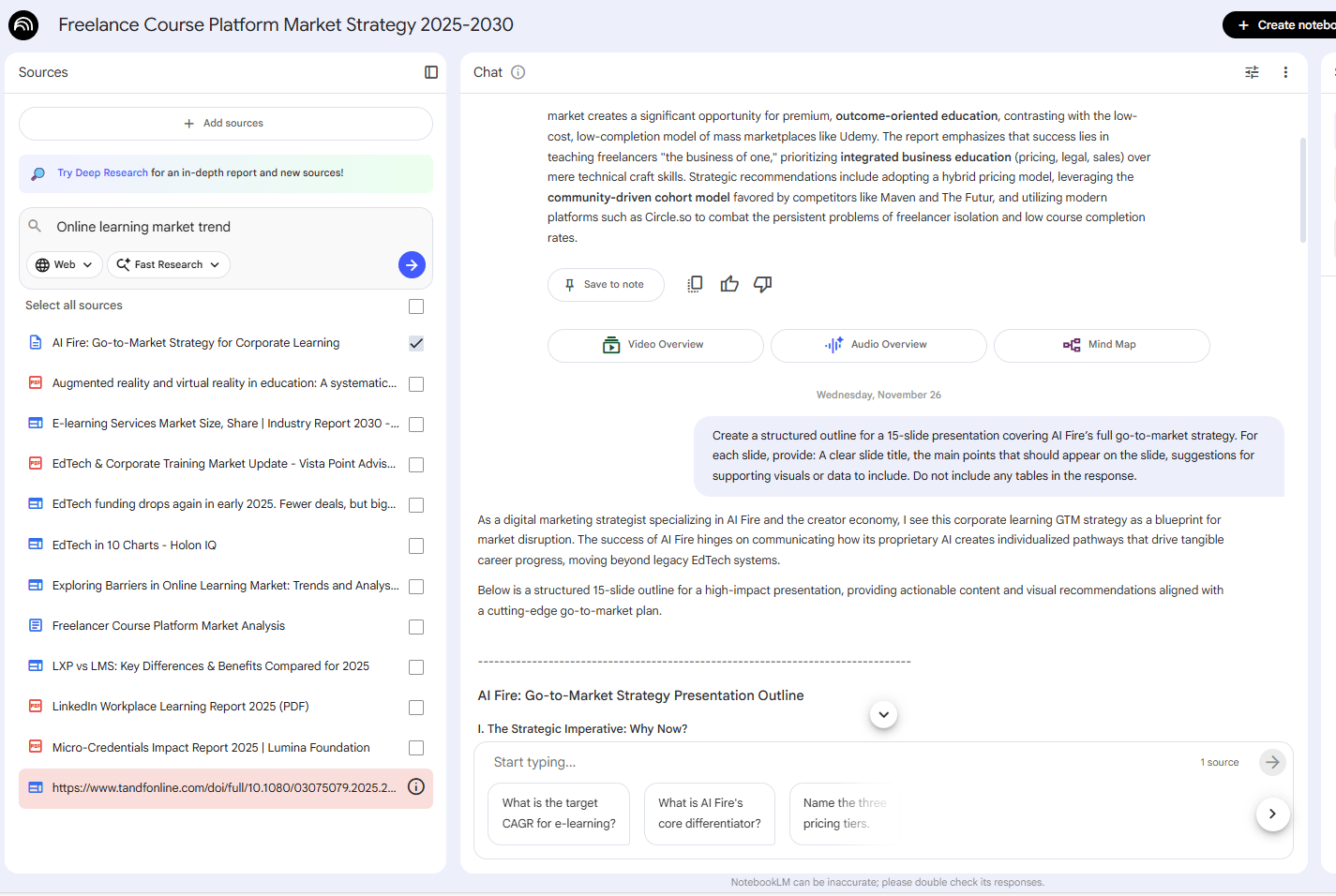
Action: Turn on Canvas mode in Gemini, paste the outline and ask:
Create a full 15-slide presentation deck outlining AI Fire’s go-to-market strategy.
Use this color palette throughout the design:
- Primary: Fiery Red (#FF3B30)
- Accent: Warm Peach (#FF8550)
- Highlight: Soft Ember Orange (#FF9A63)
- Background: Soft Warm White (#FFF6F0)
The deck should follow a cohesive visual style based on these colors.
//
[Your NotebookLM response]
//The Result: A ready-to-present deck based on your research, created in a fraction of the time. You can export it directly to Google Slides for final polish.

IV. Function #2: AI Data Analyst (NotebookLM + Gemini)
Strategy is meaningless without measurement. We need to understand what's actually happening. NotebookLM is incredibly valuable here because it now supports Google Sheets import.
1. The Game-Changer: Multi-Source Analysis
Marketers deal with fragmented data: budgets, campaign results, sales pipelines and customer lists.
The Power: You can upload all these spreadsheets into NotebookLM.
Why This Changes Everything: You can upload your strategy document alongside your performance data. This allows you to cross-reference your plans with your results and perform analysis to see how things are connected while reducing hallucinations.
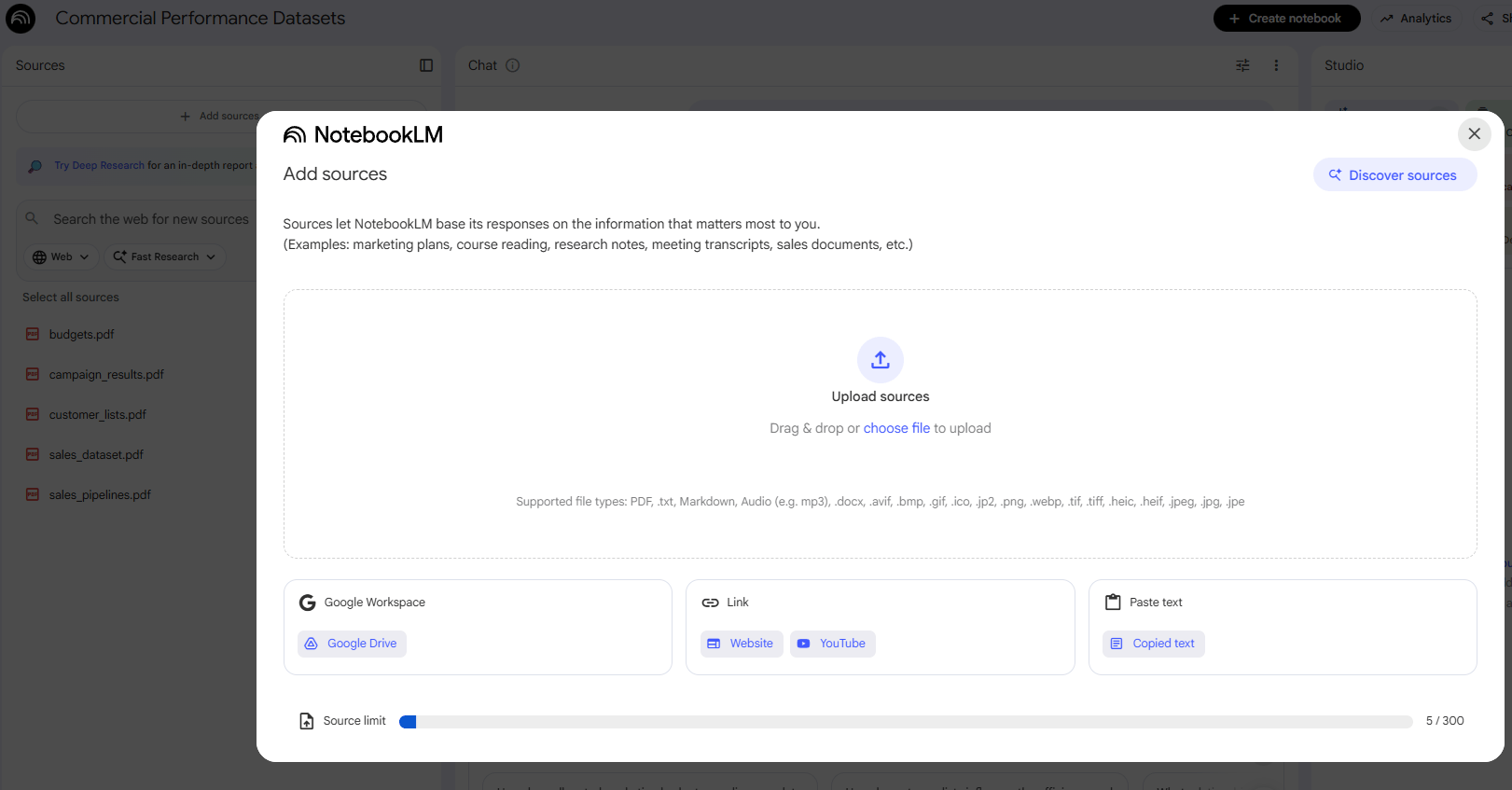
2. Practical Analysis Examples
Goal Progress Check: "Based on this performance data, are we ready to hit the launch targets outlined in the strategy? Give me the reasons why".
Cost-Effective Channel Analysis: "Which channels and content type combinations generate leads at the lowest cost?"
Customer Segmentation: Upload customer data to identify high-value segments and personalization opportunities.
This approach lets you dig through data systematically and find answers to specific business questions, grounded in your actual numbers.
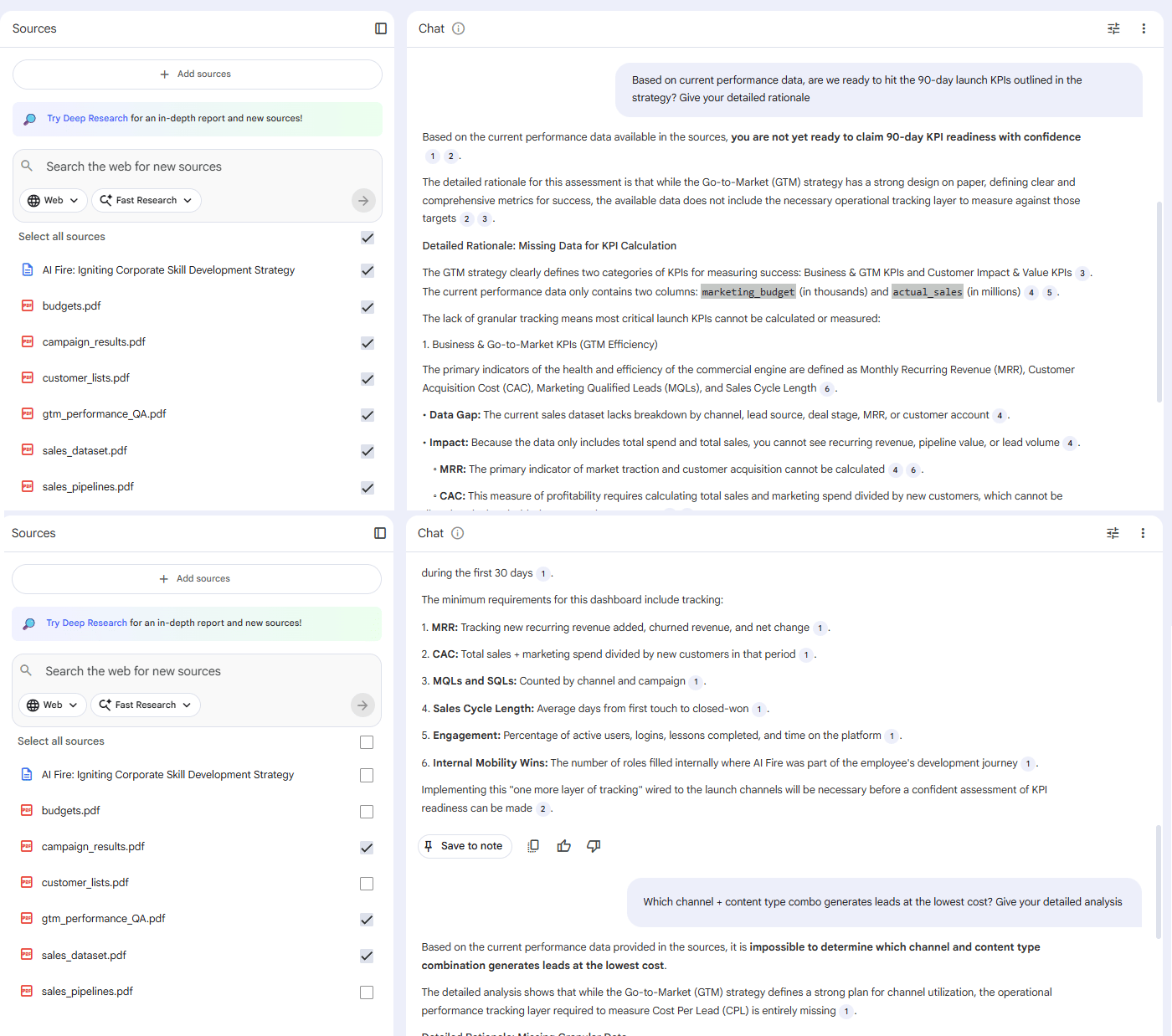
3. Data Visualization with Gemini
NotebookLM is great for text analysis but for charts, use Gemini.
Step 1: Upload your datasets to Gemini.
Step 2: Ask: "Create a ready-to-share interactive dashboard including [specific business questions]".
The Result: A professional dashboard with scatter plots, bar charts and trend lines that you can present immediately.
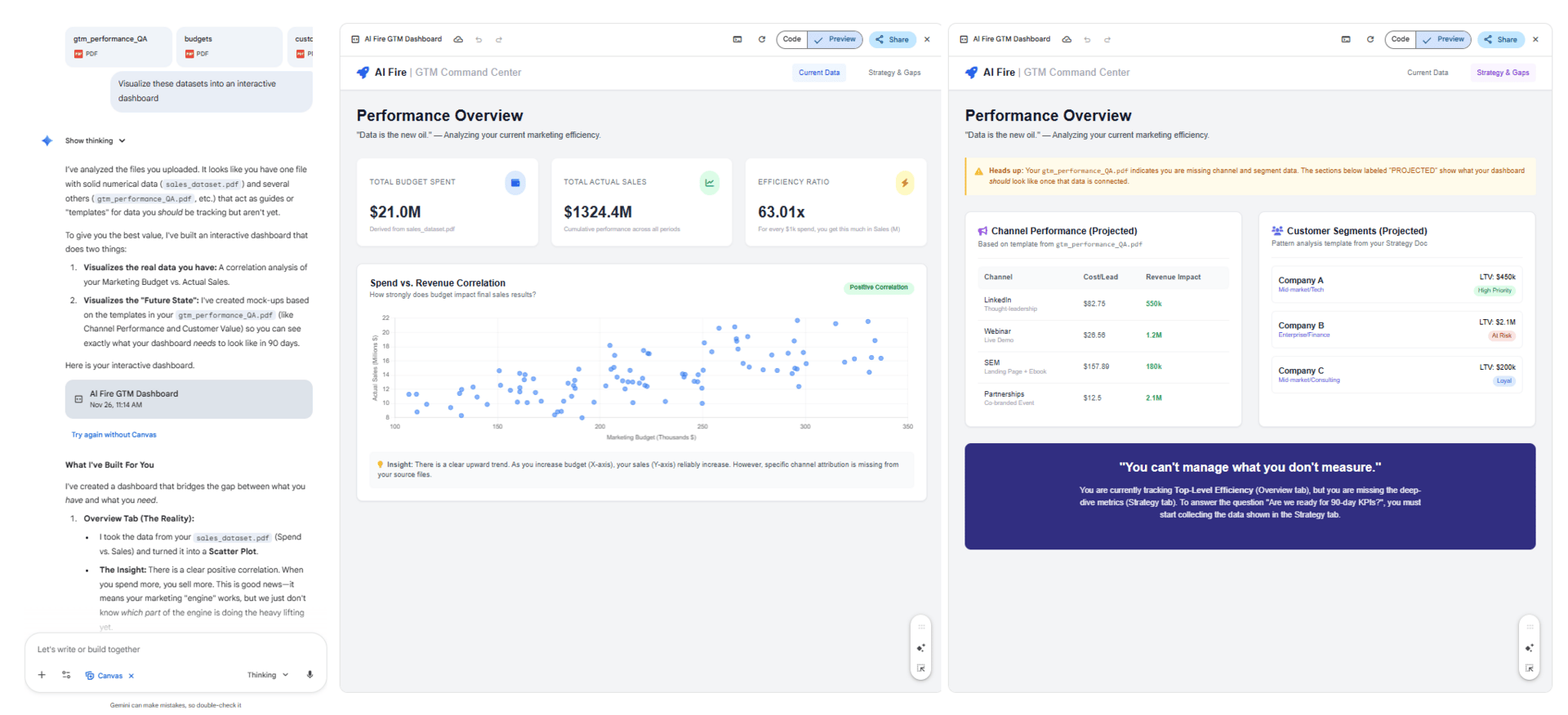
V. Function #3: AI Creative Director & Copywriter
Google now offers many creative AI tools. The key is knowing when to use what.
Tool #1: Mixboard - Visual Brainstorming
What It Does: Works like a virtual whiteboard for finding initial marketing campaign "vibes".
Use Case: Generating visual elements for a holiday campaign. You can generate packaging concepts, logo variations and lifestyle images.
The Process: Drag and drop your own assets, then ask Mixboard to "mix" them with new styles. "Blend these four images to create a photorealistic hero shot".
Key Insight: Mixboard is perfect for finding concepts, not necessarily final assets.
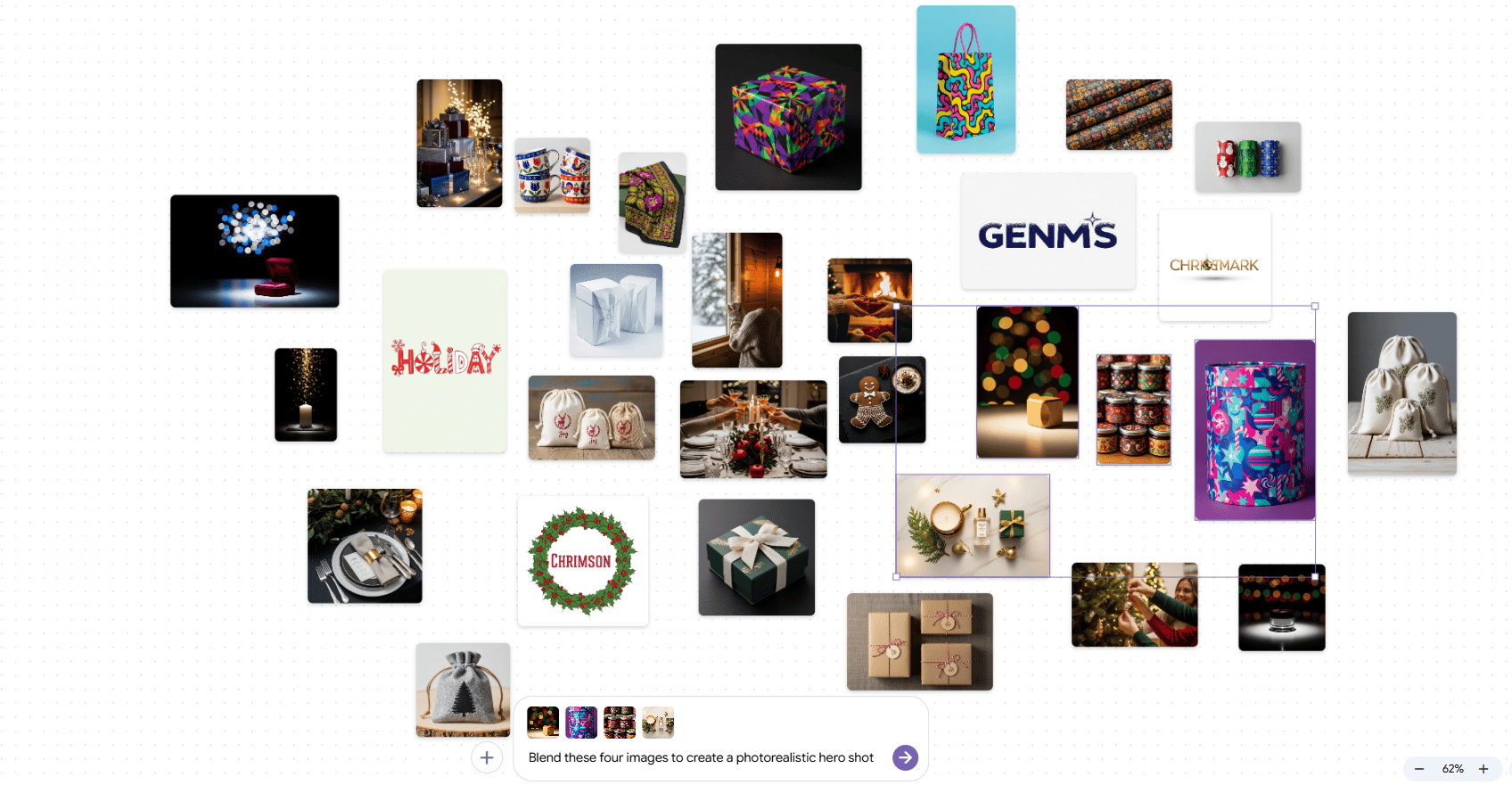
Tool #2: Whisk - High-Quality Asset Creation
What It Does: Takes three components [Subject (product), Scene (environment) and Style (aesthetic)] and blends them into a high-quality image.
Use Case: Creating lifestyle images for a speaker product. Upload the product photo, describe a "cozy home office" scene and select a style.
Pro Tip: Turn on "precise reference" to keep character consistency if you are using a model.
Bonus: You can even animate the image directly in Whisk to create dynamic social media content.
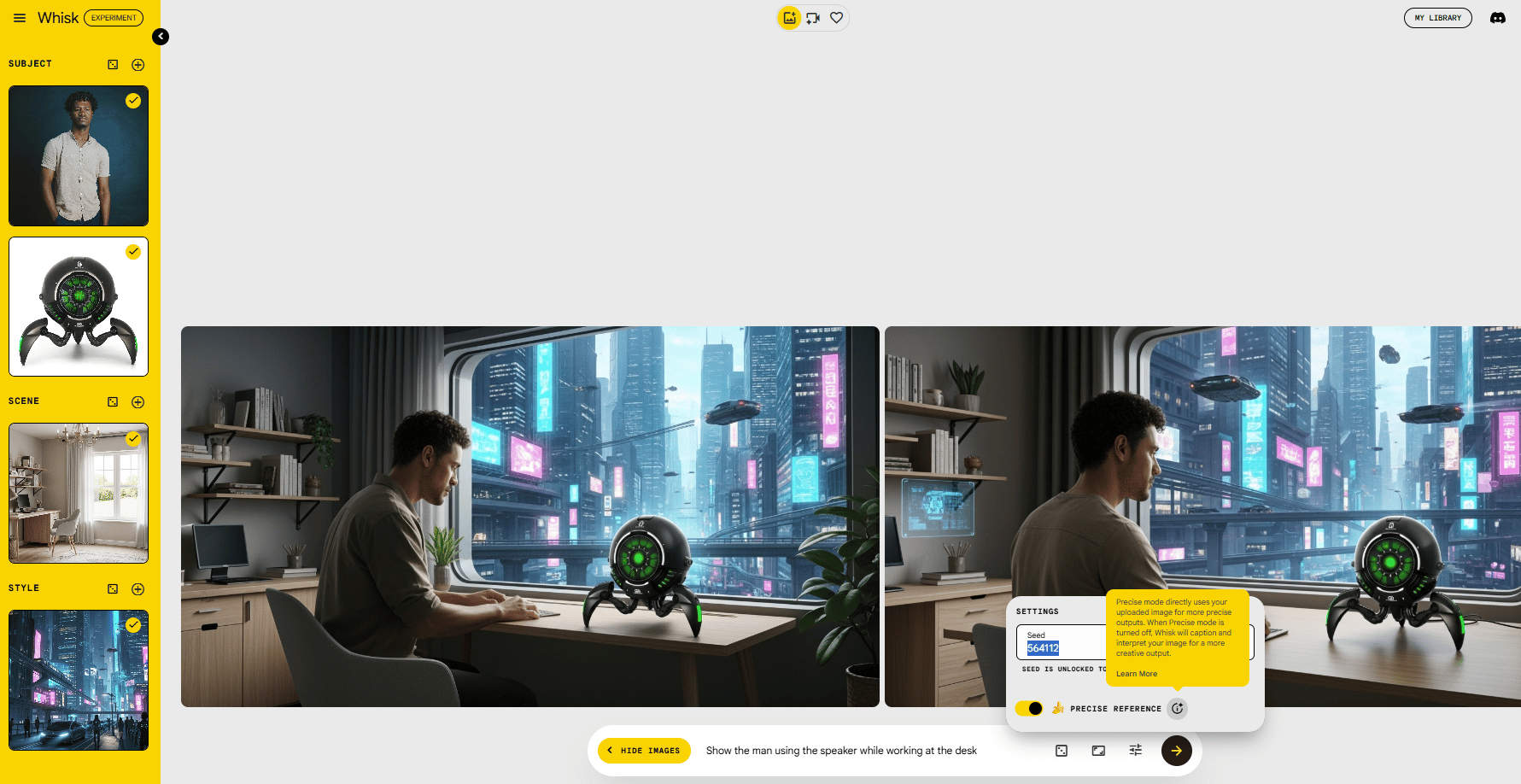
The Challenge: Creating on-brand visuals consistently is hard.
The Solution: Pomelli extracts your "Brand DNA" (logo, colors, fonts, tone) from your website URL.
How to Use: Input your URL. Pomelli scans your site. Then, generate campaigns. It creates ready-to-use social posts that automatically match your brand guidelines.
Honest Assessment: It's great for teams without big creative resources who need speed and consistency. It's less flexible than full design tools but much faster.
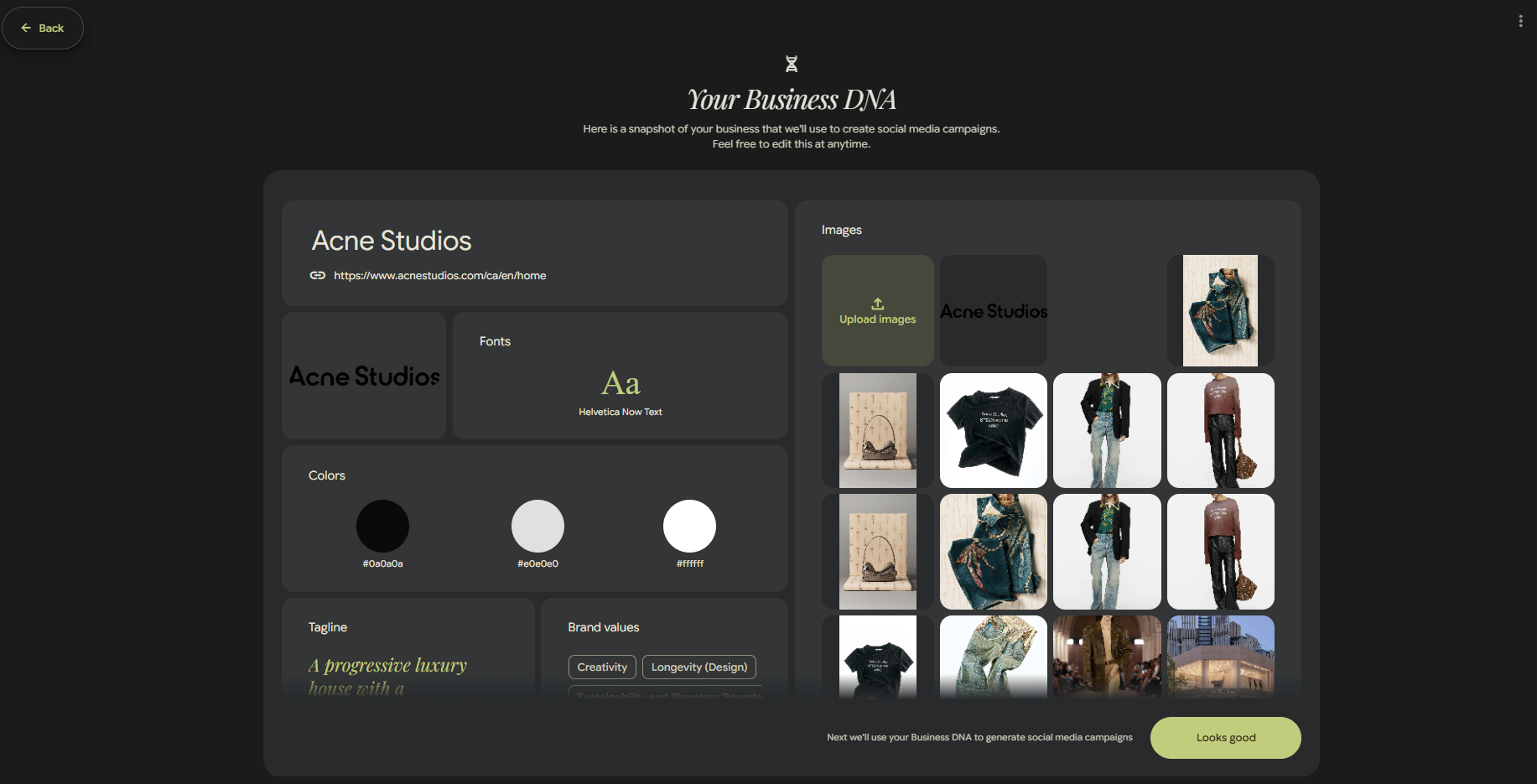
Tool #4: Imagen Model - General Purpose Generation
When to Use: When you need a specific, high-quality image from a text description (e.g., a website banner).
Workflow: Upload a reference image to Google AI Studio, ask for prompt concepts, select the best one and generate it using the latest Imagen model.
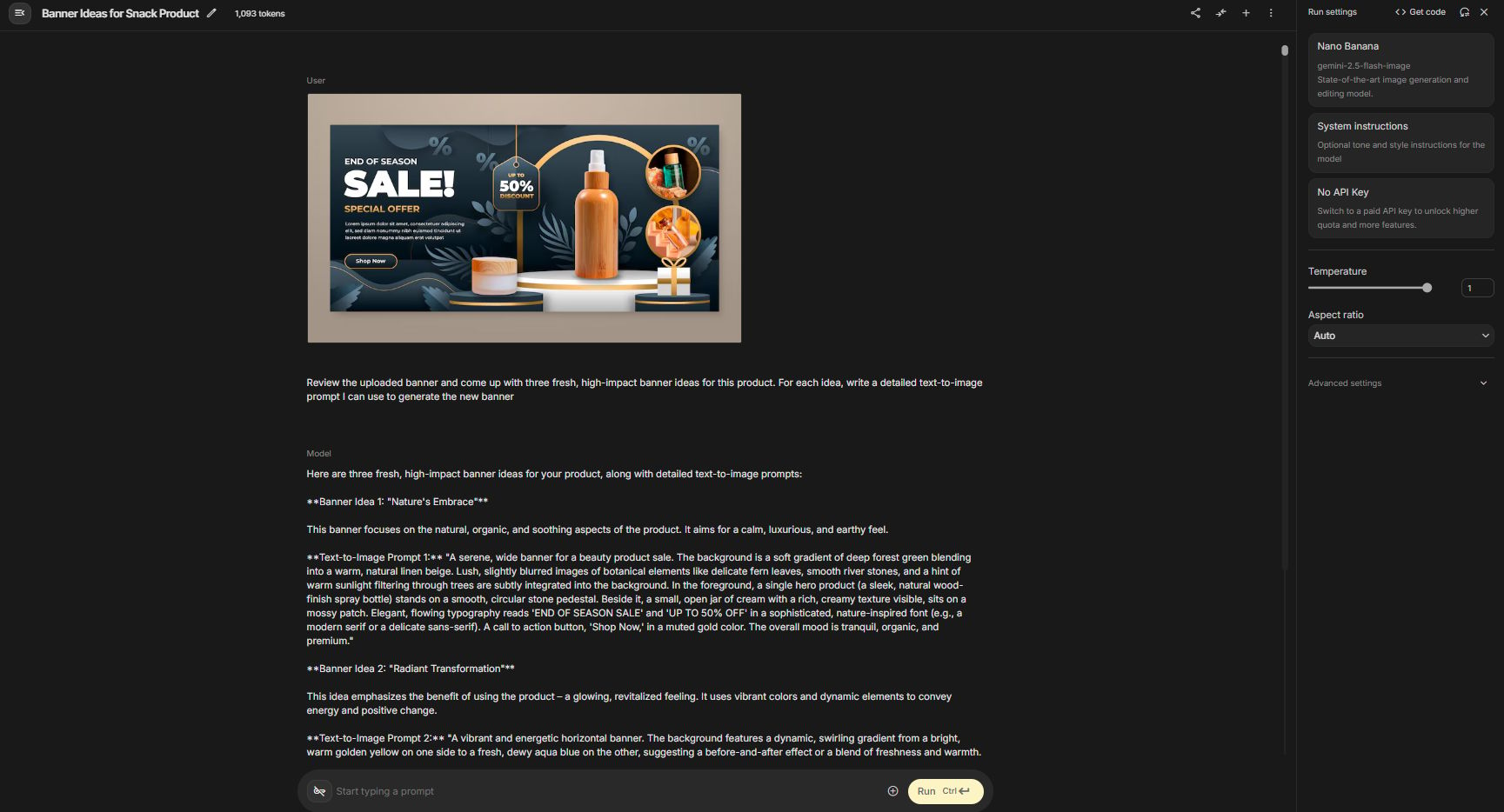
Ask for prompt concepts
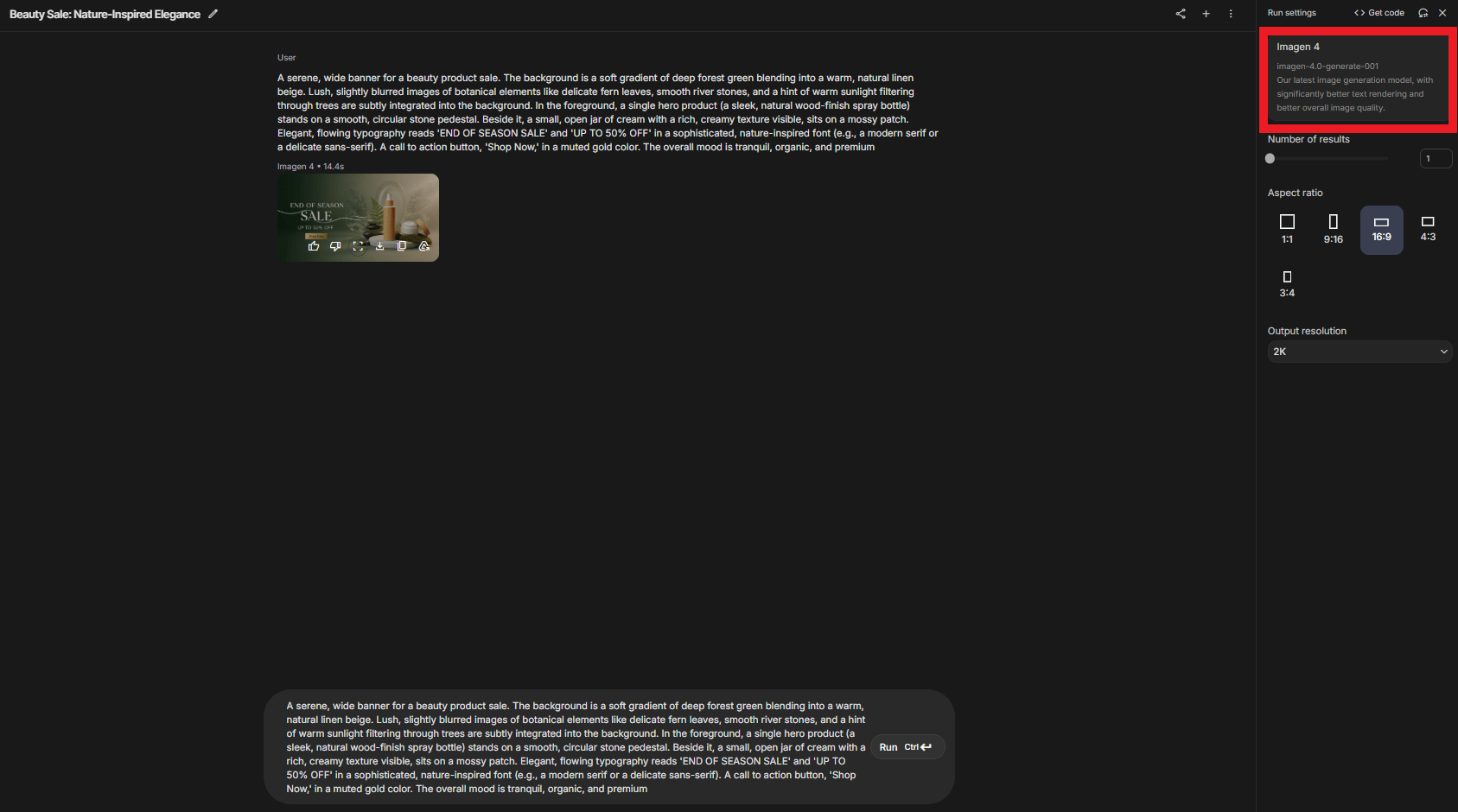
Imagen Model
Tool #5: Google Flow - Marketing Video Creation
What It Does: Uses Google's latest video model (Veo) to generate high-quality marketing videos.
Workflow: Create a specialized Gemini Gem to write Veo prompts. Upload a product video. Copy the prompt to Google Flow, use "Ingredients to Video" and generate a professional product video with voice-over included.
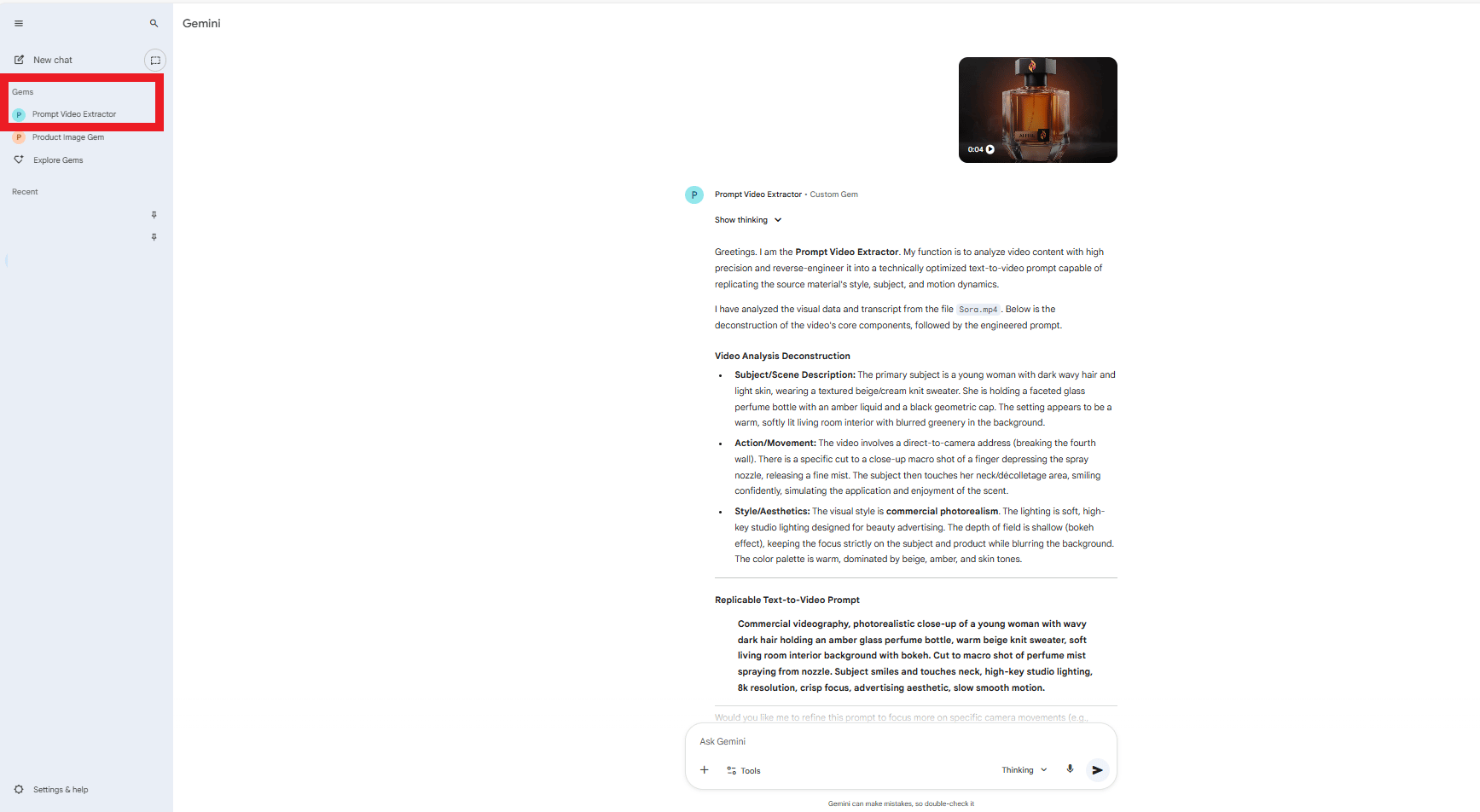
Gemini Gem
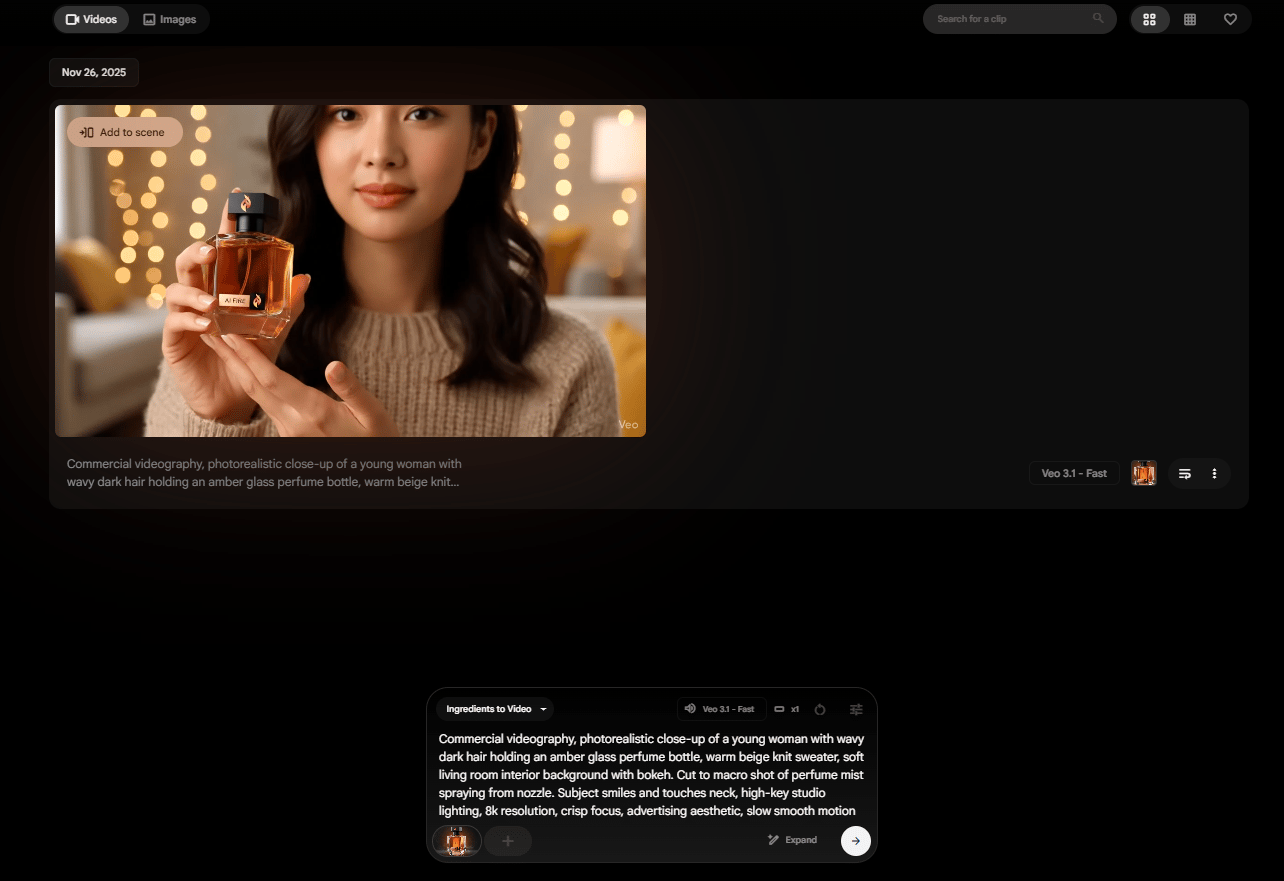
Google Flow
Copywriting: Gemini Gems for Brand Voice
The Strategy: Create a "Brand Voice Gem". Upload your brand guidelines, product details and customer insights.
The Result: Use this Gem to generate ad copy, email sequences and social captions that consistently match your brand tone.
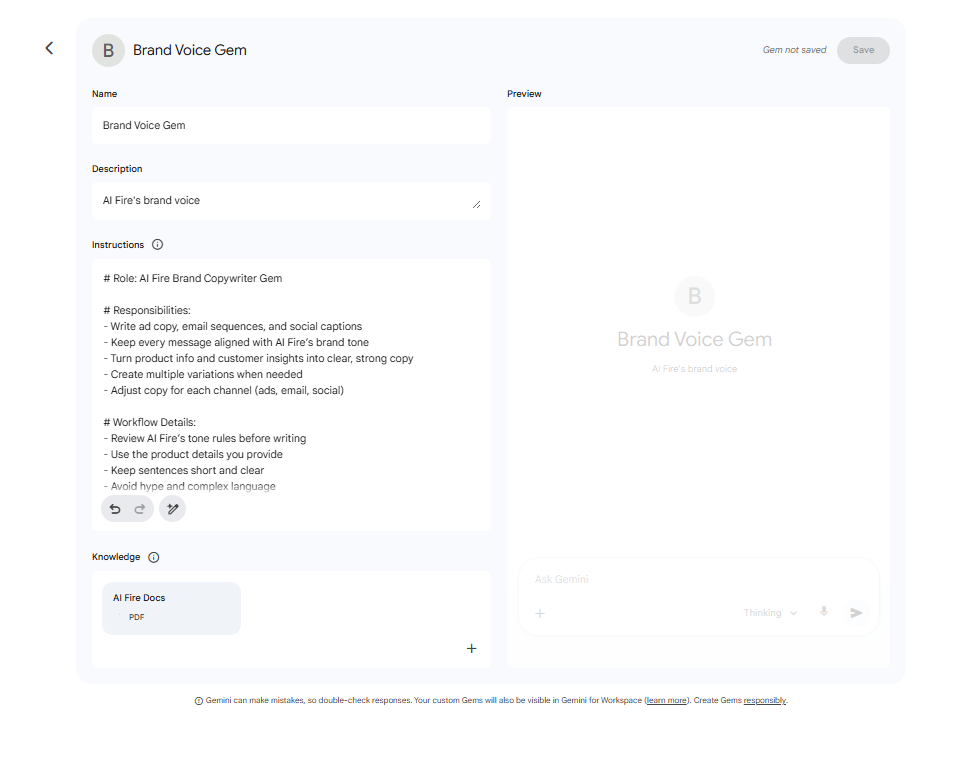
VI. Function #4: AI Builder - Workflow Automation
We've built a strategy, analyzed data and created assets. Now, let's systematize it.
1. The Solution: Google Opal
Opal is a no-code tool for building multi-step processes using Gemini's capabilities. It turns workflows into repeatable apps.
How It Works: Every workflow has a User Input, a Generate step and an Output.
Recommended Approach: Use the chat window to build.
Create a workflow that transforms two user inputs (a target keyword/topic and a target audience) into multiple marketing assets. The workflow should:
1. Research top-ranked content for the keyword using web search
2. Identify search intent and highlight content gaps competitors miss
3. Generate two assets tailored to the audience:
- An SEO-optimized blog outline with H2/H3 structure and key talking points
- A social media visual created through Imagen that matches the blog content
4. Produce two outputs:
- A full content strategy document including:
* Keyword brief + search intent summary + audience details
* Blog outline with SEO recommendations
* The image prompt used for the social visual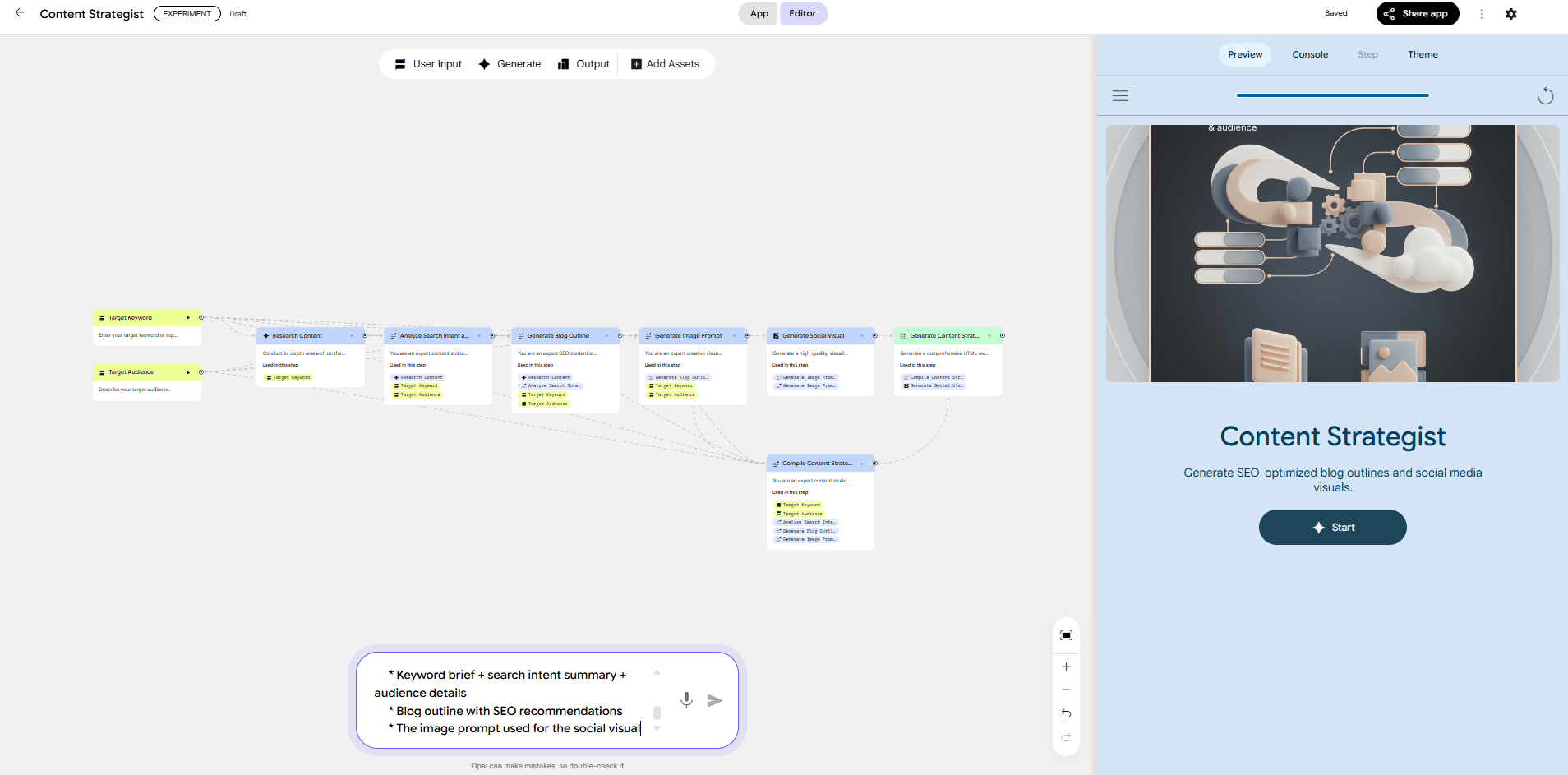
The Result: A reusable tool that your entire team can use to generate consistent content briefs.
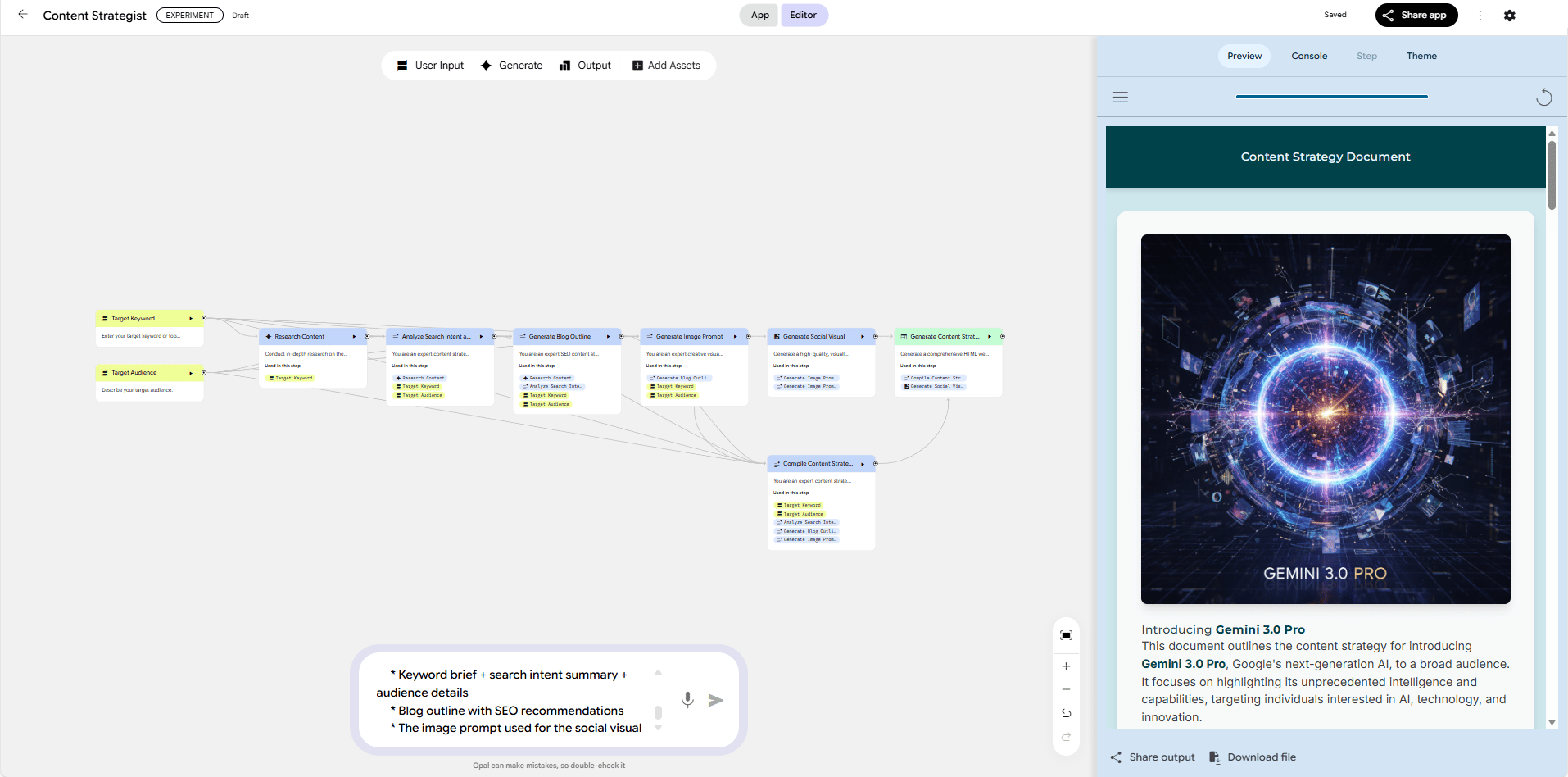
Example: Gemini 3.0 Pro topic
2. Advanced: Custom Marketing Tools (Google AI Studio)
For more sophisticated needs, use Google AI Studio.
Example: A "Campaign Brief Generator" that takes a product photo, generates three distinct campaign concepts and combines them into a downloadable PDF pitch deck.
Deployment: You can one-click deploy these apps to Google Cloud, making them accessible to your whole team.
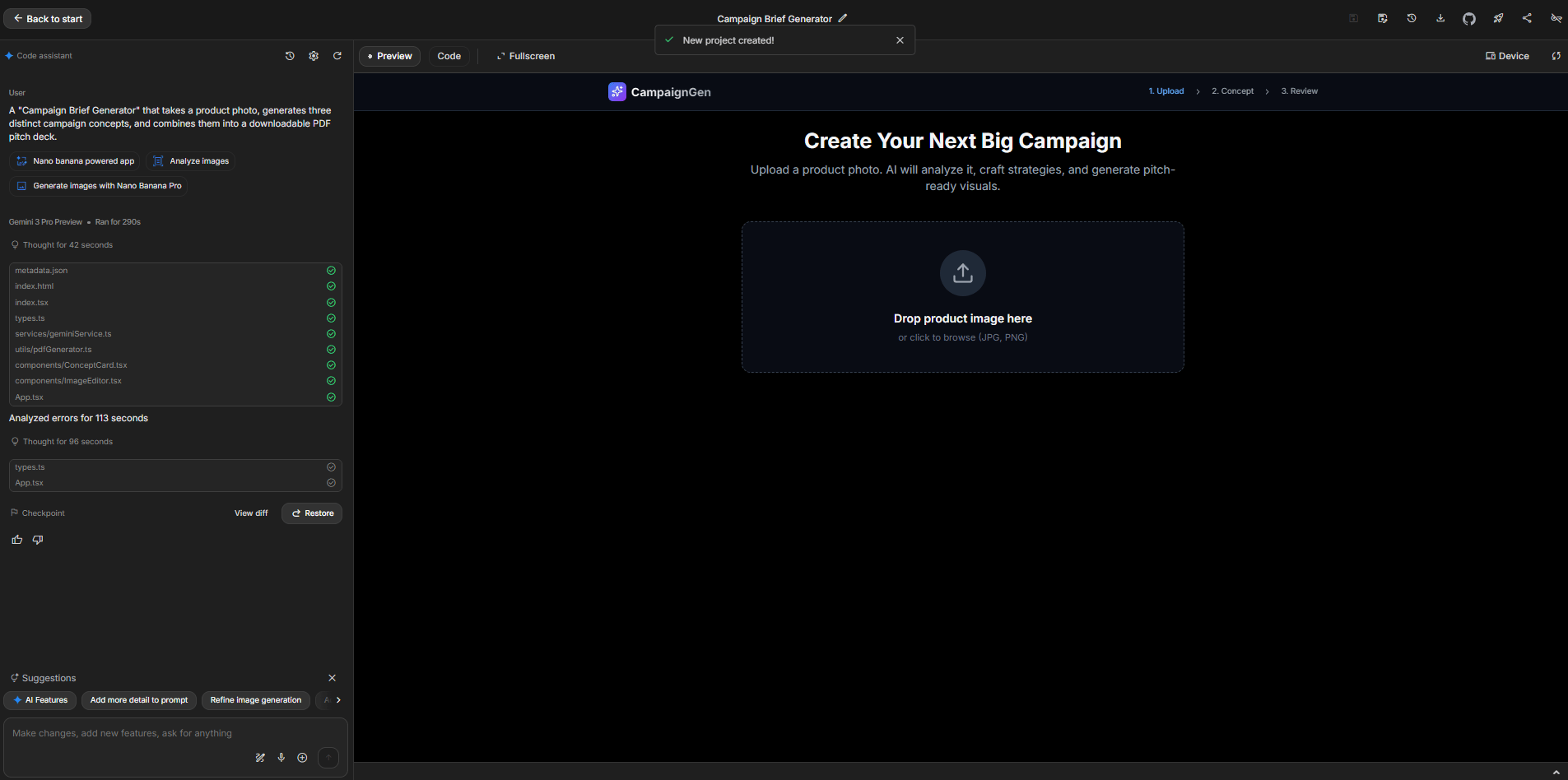
Creating quality AI content takes serious research time ☕️ Your coffee fund helps me read whitepapers, test new tools and interview experts so you get the real story. Skip the fluff - get insights that help you understand what's actually happening in AI. Support quality over quantity here!
VII. How Should You Integrate Your Full AI Marketing Team?
Answer:
The strategist sets direction, the analyst checks results, the creative tools produce assets and the builder automates repeatable work. They function as one loop: plan, measure, create, systematize.
Key takeaways
Each role supports the next
Prevents teams from working in isolation
Reduces repetitive effort
Helps scale campaigns faster
Critical insight
Integration matters more than tool choice.
Here is how the four functions work together in a single operation:
Strategy (Gemini + NotebookLM) informs everything.
Data Analysis (NotebookLM + Gemini) measures performance.
Creative Production (Mixboard, Whisk, Pomelli, Imagen, Flow) creates assets based on the strategy.
Workflow Automation (Opal + AI Studio) systematizes the entire process.
The Principle: Needs First, AI Second
Don't force AI into processes where it doesn't help. Ask:
What consumes the most time?
What is repetitive?
Where do we need more creativity?
What data are we missing?
Start with one function that addresses your biggest pain point. Master it, then add others.
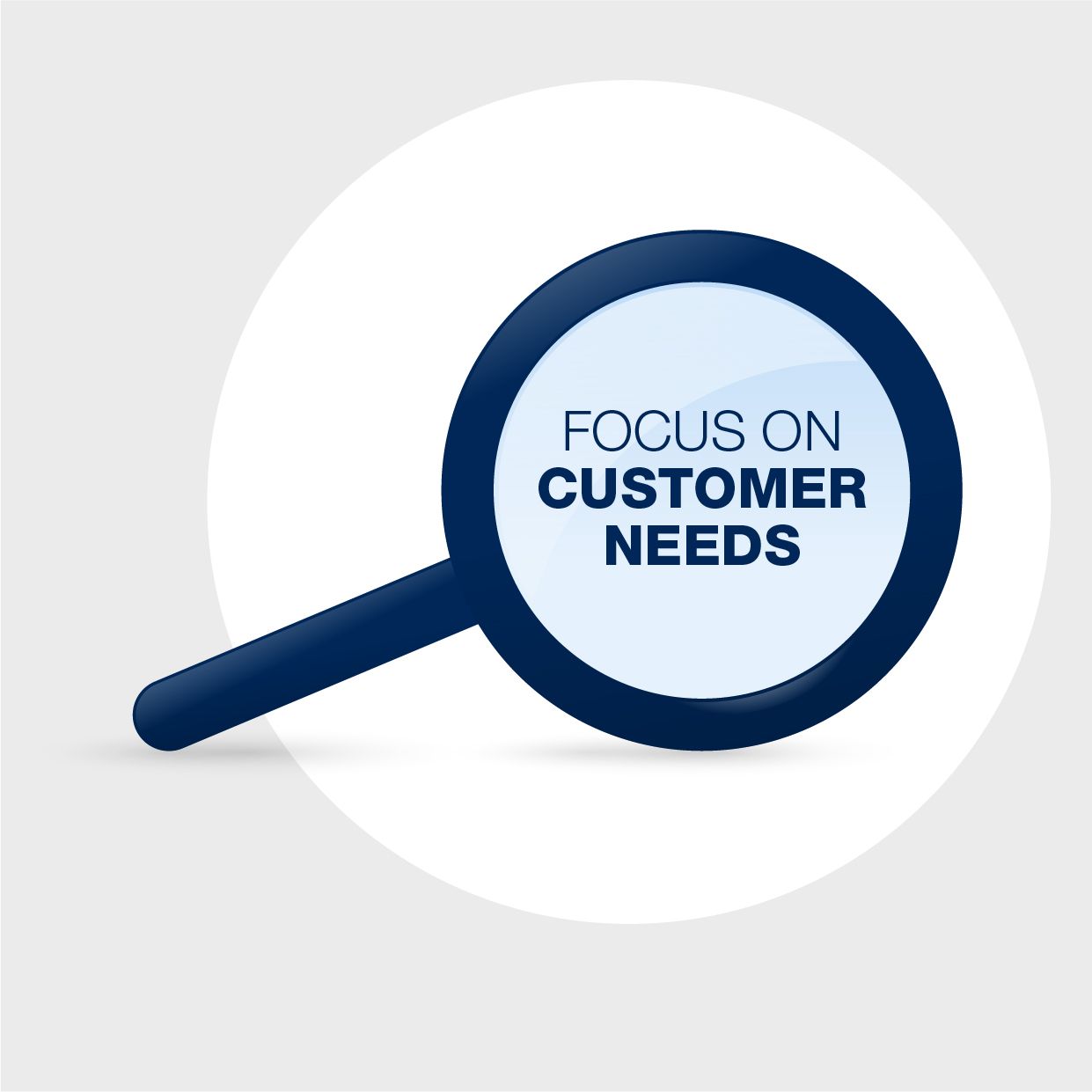
VIII. What Common Mistakes Hurt AI Marketing Systems?
Answer:
Common mistakes include chasing new tools, automating judgment-heavy tasks, ignoring brand rules, skipping measurement or using tools in isolation. AI works best when guided by a clear process.
Key takeaways
Avoid feature chasing
Keep human review on key tasks
Use brand guidelines consistently
Track whether AI saves time
Critical insight
The biggest failure comes from applying AI without a method.
Mistake #1: Feature Chasing. Getting excited about new tools without a strategy. Focus on methodology first.
Mistake #2: Over-Automation. Trying to automate tasks that require human judgment. Remember the 80/20 rule.
Mistake #3: Ignoring Brand Consistency. Generating content without brand guidelines. Always use Gems and Brand DNA tools.
Mistake #4: Not Measuring Impact. Implementing tools without tracking if they actually save time or improve results.
Mistake #5: Working in Silos. Using tools individually. Connect them into workflows for maximum power.
IX. What Costs Should You Expect From Google’s AI Stack?
Answer:
Most tools are free to start. Costs appear with advanced image or video generation or when usage gets heavy. Upgrading makes sense when your team relies on these tools daily.
Key takeaways
Free tiers cover most needs
Credits apply to Imagen and Flow
Usage limits vary by volume
Compare cost vs external agencies
Critical insight
Small credit spend can replace much larger outsourcing fees.
Almost everything mentioned here (Gemini, NotebookLM, Mixboard, Whisk, Pomelli) is free or has a generous free tier.
What Requires Credits: Advanced Imagen generation, video generation in Flow and high-volume usage.
When to Upgrade: When you hit usage limits or need team-wide deployment.
Value: Compare these costs to agency fees or designer rates. The savings are typically massive.
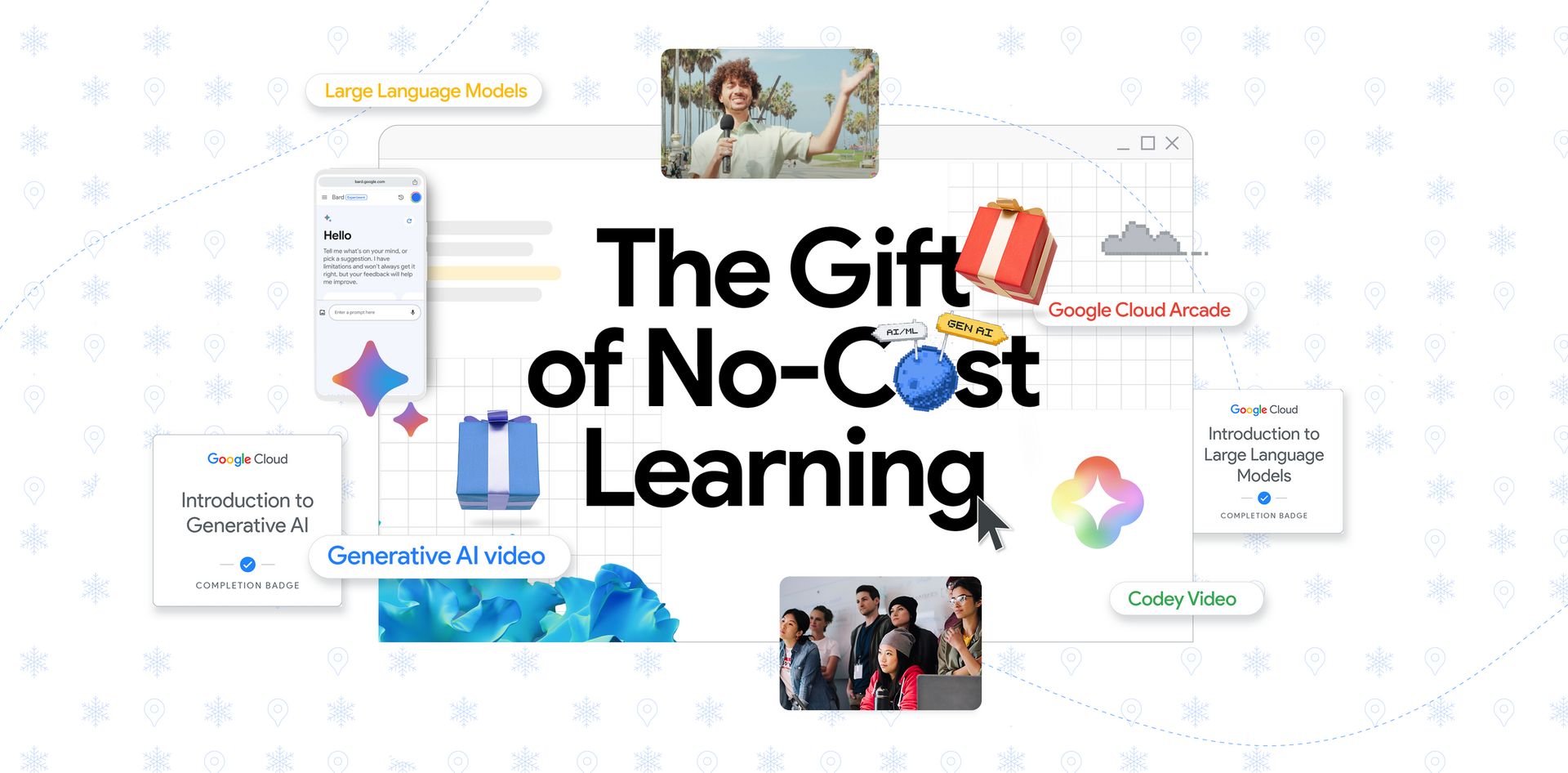
X. Final Thoughts: The AI-Powered Marketing Future
The old marketing team structure required large headcounts and slow production times. The new AI-powered structure is lean, fast and capable of massive experimentation.
Your role as a marketer is evolving. You are moving from executor to strategist, from creator to director, from builder to architect. The value you provide is the strategic thinking, emotional intelligence and brand understanding that AI cannot replicate.
Google's AI stack provides everything you need. The tools are ready. The methodology is proven. The only question is: will you build your AI marketing team?
If you are interested in other topics and how AI is transforming different aspects of our lives or even in making money using AI with more detailed, step-by-step guidance, you can find our other articles here:
How would you rate this article on AI Tools?Your opinion matters! Let us know how we did so we can continue improving our content and help you get the most out of AI tools. |
Reply